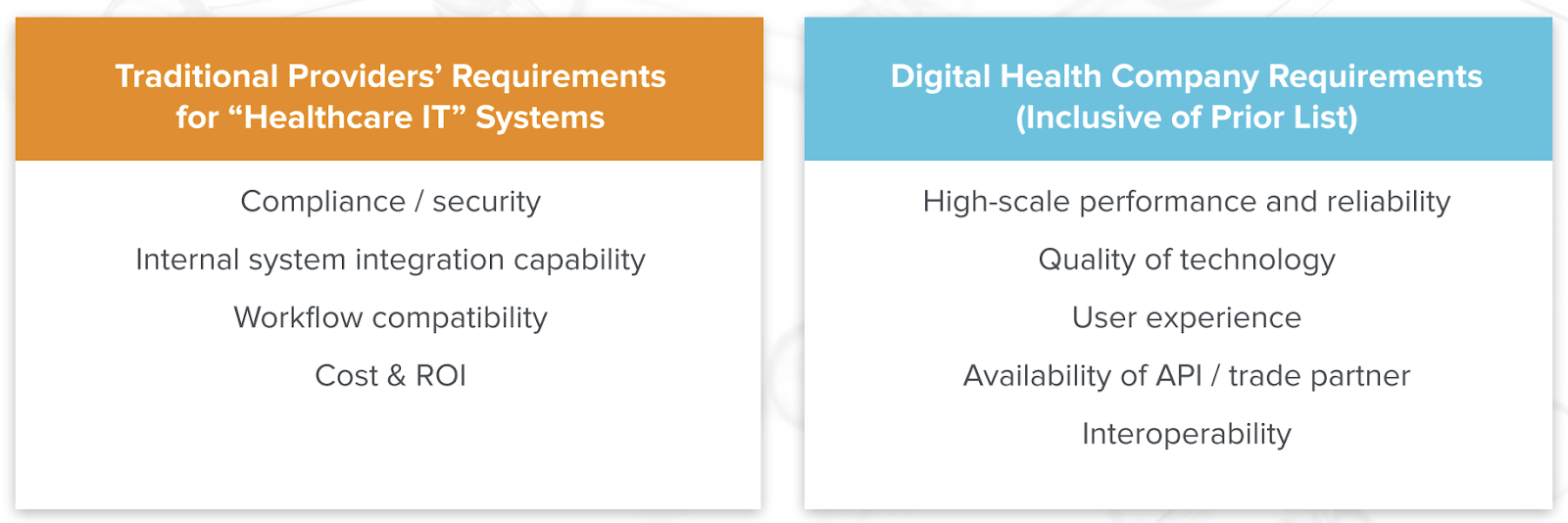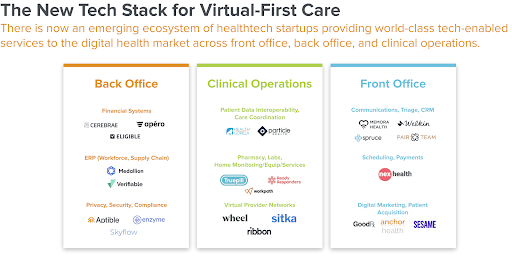Mar 8
2021
API-First Solutions Are Becoming The Foundations For Telehealth Efficiently and Scale
By Nick Macario, CEO, Verifiable.

Andreessen Horowitz, one of the most well-known venture capital firms in Silicon Valley, having made notable exits including Airbnb, Facebook, Box and Slack, is often at the precipice of significant software trends, including those signifying industry disruption. The firm is taking some of its focus on the rapid innovation occurring within the digital health space.
For example, Julie Yoo, general partner at Andreesen Horowitz, recently issued a report defining “The New Tech Stack For Virtual First Care.” In the report, Yoo says API-first solutions are, and will continue, helping telehealth companies rapidly build more scalable, efficient operations.
Digital Healthcare Surges As the World Focuses On Patient Care
For obvious reasons the recent growth in the overall digital health market has been explosive. Yoo points out that 2020 was a record-breaking year in the number of digital health companies that got started and funded, as well as the extensive growth these platforms achieved in both patient utilization and revenue. In her analysis, more than 1,000 full-stack digital health companies began in the past three years.
“We’re truly entering into a new golden era for healthcare technology,” she noted in her report.
Legacy Healthcare IT Fails Digital Health
New virtual care companies require much of the same back-end infrastructure as traditional healthcare providers; however, legacy healthcare IT solutions lack flexibility, interoperability, and scale required. Many digital health companies are trying to build their tech stacks or outsource manual operations — either approach is a mistake.

(Image source from “New Tech Stack of Virtual Care Delivery,” Andreessen Horowitz)
The “New Tech Stack For Virtual First Care”
Yoo point out that “in the same way that Plaid, Stripe and AWS abstracted out entire layers of infrastructure and dramatically reduced the cost and time to stand up a new tech business, these health-tech companies are now allowing digital health startups to accelerate their time to market and really focus on the higher-order elements of their products and services to deliver game-changing care to patients.”
Strong digital health growth is spurring a new wave of health technology infrastructure, “The New Tech Stack For Virtual First Care.”
This new stack spans the front office, clinical, and back office operations. By providing flexible, scalable API-first offerings, digital health companies can integrate and configure them to fit their needs, tipping the scales of the “buy vs. build” decision. This allows telehealth companies to reinvest realized efficiencies and cost-savings back into delivering great care and value for their end users.

(Image source from “New Tech Stack of Virtual Care Delivery,” Andreessen Horowitz)
APIs For Powerful Provider Data Management
A significant pain point for both virtual first care and traditional healthcare delivery has been the tedious status quo for verifying provider licenses and credentials. Manual, time-consuming, one-by-one style workflows have typically required healthcare organizations to build out teams of operational staff to manage these processes, often with limited effectiveness. License verification and credentialing workflows often become bottlenecks with long turnaround times, limiting ability to scale with volume and magnets for risk as regulations change or continued follow-up is needed.
In partnering with telehealth and virtual care companies, Verifiable, for example, has witnessed three areas in which more flexible APIs for provider credential verification and monitoring have had the most immediate impact.
Provider Onboarding
The “Old Way”: Intake of provider data has historically been difficult within the traditional healthcare space, involving paper, fax machines, or multiple email communications. While many digital health and virtual care providers have modernized this process through onboarding forms like Google Forms and Survey Monkey to capture data, these do little to catch entry errors, require endless entry fields and result in the data existing outside systems of record.
The “New Wave”: With API-first data solutions embedded into onboarding forms, provider data can be quickly pre-populated from an NPI or Social Security number, reducing friction within the provider onboarding process and minimizing the risk of poor data entry (that will cause significant delays later). Real-time data verifications can even be embedded directly into these forms, providing immediate feedback and prompts to busy providers in the same session to update incorrect information. This validated data from these verifications can now also be re-used without cost throughout subsequent processes like network approval, credentialing or enrollment.
Credentialing and Enrollment
The “Old Way”: This tedious process either required healthcare organizations to work with slow, expensive, inflexible outsourced solutions where they had little control over their own data, or build out teams in-house to manually perform one-off primary source lookups across disparate data sources, track any changes and compile results in a compliant manner.
The “New Wave”: Now starting with high-quality, validated data flowing from onboarding, fast-growing healthcare organizations are using modern solutions, leveraging its powerful data-matching algorithms to automate primary source verifications across hundreds of sources and obtain instant results. Beyond the digitized data populating directly in core systems of record, screenshots and audit logs are also auto-captured to meet the highest levels of NCQA compliance. With complete control over their provider data digitized and integrated within core platforms, modern healthcare companies can now develop advanced reporting and tooling or further automate and streamline provider enrollment activities.
Provider Network Monitoring
The “Old Way”: Tickler files, calendar reminders, ongoing monitoring of provider networks has historically been a time-consuming and haphazard process. It either is a complete resource drain for in-house teams, or an expensive black box with little visibility or quality control when outsourced. As telehealth grows and further depends on a distributed provider network to deliver greater access to care, so does the criticality for these companies to maintain and monitor their quickly evolving provider networks.
The “New Wave”: With the fast pace that many telehealth and virtual care companies are moving, they’re looking for flexible API-first solutions that can keep pace with and integrate directly into their operations. By piping directly to hundreds of primary sources, sanctions and exclusions, DEA, OIG, SAM and other sanctions and exclusions lists, newer monitoring solutions can now deliver instant alerts as statuses change or issues arise.
Again, robust APIs here are key as it allows these alerts to be delivered directly into the core systems the operations team is already using most.
Wrapping Up
Healthcare has fast forwarded 10 years worth of advancement in a matter of 10 months, which has allowed for many of the 1,000 recently formed digital health startups to quickly gain traction, as well as more established players capitalize. Though, only now is the telehealth sector achieving the critical mass necessary to support this ‘new wave’ of modern healthcare infrastructure that enables (versus hamstrings) the efficient delivery of virtual first care.
One particular area of this tech stack that has remained time-consuming, unreliable and highly inefficient has been in the end-to-end workflows related to provider onboarding, credentialing, and network monitoring.
A “new wave” of API solutions is coming along to verify and monitor provider data seamlessly throughout core workflow and creating back-end infrastructure to help digital health companies effectively scale to meet demand, deliver a better provider experience and unlock new possibilities through flexible, digitized data.